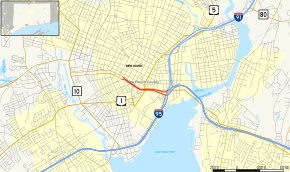Oak Street Connector
| ||||
|---|---|---|---|---|
| Oak Street Connector | ||||
 Map of New Haven County in southern Connecticut with Oak Street Connector highlighted in red | ||||
| Route information | ||||
| Maintained by ConnDOT | ||||
| Length | 1.05 mi (1.69 km) | |||
| Existed | 1959 – present | |||
| Major junctions | ||||
| East end |
| |||
| West end | York Street in New Haven | |||
| Location | ||||
| Counties | New Haven | |||
| Highway system | ||||
| ||||
The Oak Street Connector, officially known as the Richard C. Lee Highway (named after former New Haven mayor Richard C. Lee), is a 1.05-mile-long (1.69 km) freeway section of Route 34 that is located in downtown New Haven, Connecticut, United States. The freeway begins at the junction of Interstate 95 and Interstate 91 and ends at York Street/the Air Rights parking garage.
The connector closed to westbound traffic on July 14, 2014 as part of phase one of New Haven's Downtown Crossing Project. As of 2018, it remains open to eastbound traffic, though it is expected to be closed to eastbound traffic as part of phase two of Downtown Crossing.
History
As originally planned in 1957, the Connector was supposed to extend as a full expressway extending ten miles (16 km) westward from New Haven to a proposed interchange with Route 8 in the vicinity of the towns of Derby or Shelton, depending on the alignment selected for construction. The current connector section was completed in 1959. The entire project was conceived with a dual purpose: urban renewal and traffic flow. The first goal was to completely clear this area of New Haven's downtown. The highway replaced Oak Street (formerly Morocco Street) which had been a poor area since the days when leather workers congregated along West Creek. In the beginning of the twentieth century, the area became home to many Jewish and Irish immigrants. The freeway was also meant to bring cars into the city and facilitate the east–west flow of traffic between New Haven and its growing western suburbs. Due to its limited completion, only the first goal can be said to have been fully achieved. Other plans for the highway to be extended into a larger expressway from New Haven to Peekskill, New York were shelved in the mid-1970s, following successful challenges by highway opponents. The right-of-way between Legion Avenue and Reverend Dr. Martin Luther King, Jr. Boulevard (originally North Frontage Road)[1] in New Haven to Route 10 was preserved for a future extension of the connector past Route 10 to rejoin the existing Route 34 at a signalized intersection west of Route 122 in Orange. A small portion of the planned freeway extension that was built in Orange during the 1980s is now used as a commuter parking lot.
Decomissioning
During Connecticut's budget crisis of 2002, the State of Connecticut sold off land acquired for numerous planned expressways throughout the state, including land set aside for extending the Oak Street Connector. Pfizer Pharmaceuticals purchased a portion of the Oak Street Connector right-of-way, and built a US$35 million research facility on it. The Pfizer deal ensured the Oak Street Connector could not be extended beyond its terminus at the Air Rights Parking Garage near Yale-New Haven Hospital.
After the completion of the Pfizer research facility in 2005, New Haven Mayor John DeStefano, Jr. and several leaders of local civic groups began pushing the Connecticut Department of Transportation to study removing the existing Oak Street Connector (re-routing traffic onto Legion Avenue and M.L.K. Jr. Boulevard in the process) and replacing it with buildings and developments.
The project would remove the portion of the Oak Street Connector west of S. Orange Street, creating two large parcels (divided by College Street) on which buildings and developments could be built. Inbound traffic would be re-routed onto MLK Jr. Boulevard (aka North Frontage Road) while outbound traffic would be re-routed onto Legion Avenue (aka South Frontage Road). In addition, both roads would be rebuilt and widened to accommodate increased traffic, and furnished with landscaping and bicycle lanes. The road bed of the original highway would be reused as a driveway to and from the Air Rights Garage, allowing commuters to reach the Air Rights Garage whilst avoiding cross-traffic from College and Church Streets. The segment of the Oak Street Connector east of S. Orange Street will be retained as a freeway stub connecting the new frontage streets with the I-95/I-91 interchange, which itself was also rebuilt from 2011 to 2016. The removal of the Oak Street Connector would be part of a larger project called New Haven Downtown Crossing which seeks to reconnect New Haven's street grid which was originally disconnected by the construction of the connector.
One factor that would argue against demolition of the connector is the fact that it serves as the main route for ambulances from Yale New Haven Hospital to get out of downtown, thus removing the highway would degrade service to outer neighborhoods and increase response times.
CONNDOT and the City of New Haven began preparing the environmental impact statement for removing the Oak Street Connector in 2011, and in mid-2013 construction began on phase one of Downtown Crossing began which completed the aforementioned upgrades to MLK Boulevard, as well as construction of 100 College Street. The Oak Street Connector officially closed to westbound traffic on July 14, 2014, with traffic re-routed onto the newly-rebuilt MLK Jr. Boulevard. The old roadbed remains in use as a driveway to and from the Air Rights Garage. As of 2018, the eastbound side of the connector remains open to traffic pending reconstruction of Legion Avenue.
Exit list
References
- ↑ MacMillan, Thomas (September 9, 2009). "MLK Boulevard: It's Official". New Haven Independent. Retrieved 2011-07-23. Named North Frontage Road until 2010.
